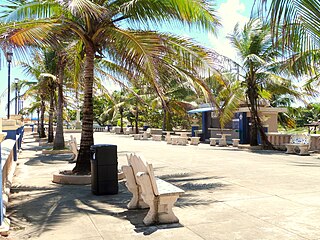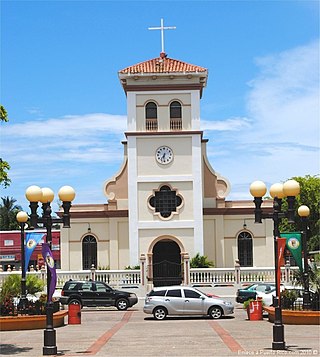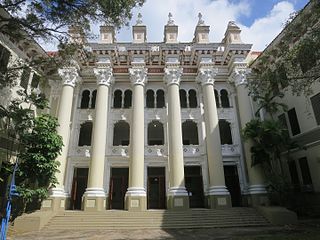
The Las Cabañas Bridge is a historic highway bridge in Adjuntas municipality, Puerto Rico. Built in 1919 to provide access to a key coffee-producing region, it was financed by nearby plantations through public subscription. Designer Rafael Nones and builder Félix Benítez Rexach, two of the most prominent figures in Puerto Rican bridge construction in the early 20th century, used a unique combination of steel and concrete technologies to produce a girder design unlike any other on the island and possibly beyond.

Casa de Piedra, also known as Residencia Amparo Roldán, in Aguadilla, Puerto Rico, is a Spanish Colonial-style home that was erected in 1875. It is the only surviving residence of its era in Aguadilla; most similar ones were damaged in the 1918 San Fermín earthquake and eventually demolished.

The Fuerte de la Concepción was a Spanish military fortress guarding the port and town of Aguadilla, Puerto Rico, in the 18th and 19th centuries. In 1986, the fort's single surviving building was listed on the U.S. National Register of Historic Places, and later on the Puerto Rico Register of Historic Sites and Zones in 2000.

Church San José of Aibonito, on the town plaza of Aibonito, Puerto Rico, was built over the ten-year period from 1887–1897. It was listed on the U.S. National Register of Historic Places in 1984, and on the Puerto Rico Register of Historic Sites and Zones in 2000.
The Lassise–Schettini House, also known as La Quinta, is a historic house in Sabana Grande, Puerto Rico. It was designed by architect Luis Perocier and built in 1924 for Dr. Enrique Lassise, a physician and "remembered good-samaritan" of the town of Sabana Grande and his wife Matilde Schettini, a schoolteacher.
Farmacia Serra is a building close to the plaza of Bayamón, Puerto Rico which was built in 1910. It was listed on the National Register of Historic Places in 1989, and on the Puerto Rico Register of Historic Sites and Zones in 2000.

Paseo Víctor Rojas, also known as El Fuerte or Paseo de Damas, in Arecibo, Puerto Rico, was built in 1881. It was listed on the National Register of Historic Places in 1986, and on the Puerto Rico Register of Historic Sites and Zones in 2000.

Antiguo Casino Camuyano is a building in downtown Camuy, Puerto Rico, which dates from 1910. It was listed on the U.S. National Register of Historic Places in 1984 and on the Puerto Rico Register of Historic Sites and Zones in 2000.

The Iglesia de Nuestra Señora del Carmen is a church in Hatillo, Puerto Rico dating from 1879. It was listed on the National Register of Historic Places in 1984 and on the Puerto Rico Register of Historic Sites and Zones in 2000.

The Iglesia San Sebastián Mártir in the plaza in San Sebastián, Puerto Rico was completed in 1897. It was listed on the U.S. National Register of Historic Places in 1984, and on the Puerto Rico Register of Historic Sites and Zones in 2001.
Alfredo Wiechers Pieretti was a Puerto Rican architect from Ponce, Puerto Rico. He was an expositor of the Neoclassicism and Art Nouveau architectural styles, doing most of his work in his hometown of Ponce. Today, Alfredo Wiechers' city residence, located in the Ponce Historic Zone and which he designed himself, is a museum, the Museo de la Arquitectura Ponceña. After enriching his hometown city with some of the most architecturally exquisite buildings, he moved to Spain arguing political persecution by the authorities in the Island.

The Chalet Amill in Yauco, Puerto Rico is a Beaux Arts style house that was built in 1914. It was listed on the National Register of Historic Places in 1985, and on the Puerto Rico Register of Historic Sites and Zones in 2001.

The José Celso Barbosa House Museum is a historic house museum in Bayamón municipality, Puerto Rico.

Central High School, also known as La Central or La Central High, is a school located in Santurce barrio of San Juan, Puerto Rico.

The Ingenio Azucarero Vives, also known as Hacienda Vives, is a historic sugar mill complex with ruins of windmill and a processing building, in Barrio Machete of Guayama, in southern Puerto Rico. Sugarcane was ground by the windmill and the extracted juice was further processed in the processing building, by slaves. A slave uprising occurred here in the early 1800s.

The La Liendre Bridge, spanning Beatriz Creek, a tributary to the Río de la Plata, between Cayey, Puerto Rico and Cidra, Puerto Rico. It was built in 1877 and was listed on the National Register of Historic Places in 1995, and on the Puerto Rico Register of Historic Sites and Zones in 2000.

The Hacienda Los Torres also known as Casona Los Torres in Lares, Puerto Rico, dates from 1846. It was listed on the National Register of Historic Places in 2006, and on the Puerto Rico Register of Historic Sites and Zones in 2007. Designed by Jose Maria Torres y Medina, it is located at the junction of Puerto Rico Highway 111 and Puerto Rico Highway 129.
Villa Julita, also known as Casa Ulrich, is a private building in Aibonito, Puerto Rico which is on the National Register of Historic Places and on the Puerto Rico Register of Historic Sites and Zones. Currently in good condition and located at its original site, it was designed by architect Alfredo Wiechers Pieretti and built by Salvador Lando, in 1915, for the Vendrell-Suárez family.

The Church San José of Gurabo is a historic Catholic parish church located in Gurabo Pueblo in the municipality of Gurabo, Puerto Rico. The parish church is part of the Roman Catholic Diocese of Caguas.

The Church Santa María del Rosario of Vega Baja is a historic Catholic parish church from 1860 located in the main public square (plaza) of Vega Baja Pueblo, the historic and cultural downtown of the municipality of Vega Baja, Puerto Rico. The parish, which is part of the Roman Catholic Diocese of Arecibo, was added to the United States National Register of Historic Places in 1984 as part of the Historic Churches of Puerto Rico thematic multiple property submission. It was later added to the Puerto Rico Register of Historic Sites and Zones in 2000.


















